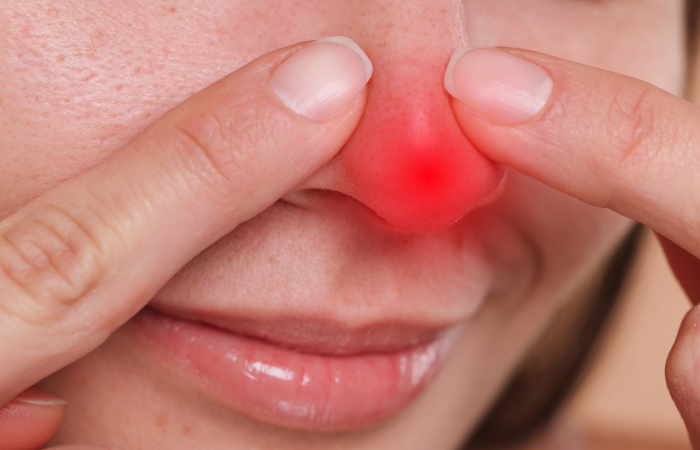Inferior Turbinate Hypertrophy

Dr. Vignesh Jayakumar
MBBS, Diploma in Otorhinolaryngology (DLO), DNB - Otorhinolaryngology ENT/ Otorhinolaryngologist

Inferior Turbinate Hypertrophy Treatment in Bangalore
Inferior turbinate hypertrophy occurs when the inferior turbinates in the nasal cavity enlarge, leading to nasal obstruction and difficulty breathing. For those seeking Inferior Turbinate Hypertrophy Treatment in Bangalore, various options are available, ranging from medications such as nasal corticosteroids and decongestants to reduce swelling, to surgical procedures like turbinate reduction for more severe cases. Consulting an experienced ENT specialist in Bangalore, such as Dr. Vignesh J, is crucial for proper diagnosis and personalized treatment. If you experience nasal congestion, snoring, or frequent sinus infections, seeking professional help from Dr. Vignesh J is essential for effective relief.
What is Inferior Turbinate Hypertrophy?
Inferior turbinate hypertrophy is a condition characterized by the enlargement of the inferior turbinate bones located inside the nasal passages. These structures help humidify and filter the air we breathe. When they become swollen or enlarged, they can obstruct airflow, leading to breathing difficulties, nasal congestion, and other related issues. Inferior Turbinate Hypertrophy Treatment in Bangalore is essential for those experiencing significant discomfort.
Common Causes of Inferior Turbinate Hypertrophy
- Allergic Rhinitis: Allergies can cause inflammation and swelling of the turbinates, leading to hypertrophy.
- Chronic Sinusitis: Persistent sinus infections can lead to the enlargement of the turbinates over time.
- Environmental Irritants: Exposure to smoke, pollution, or strong odors can irritate the nasal tissues, causing the turbinates to enlarge.
- Hormonal Changes: Hormonal fluctuations during pregnancy or puberty can lead to increased turbinate size.
Common Symptoms of Inferior Turbinate Hypertrophy
- Nasal Congestion: Difficulty breathing through the nose, particularly when lying down or during physical activity.
- Reduced Sense of Smell: Swelling can impair the sense of smell, making it less effective.
- Frequent Sinus Infections: Blocked airways may lead to recurring sinus infections and related symptoms.
- Postnasal Drip: Excess mucus can accumulate, leading to a feeling of mucus dripping down the throat.
- Mouth Breathing: Increased nasal obstruction can cause individuals to breathe through their mouths, especially at night.
Benefits of Inferior Turbinate Hypertrophy Treatment
- Improved Nasal Breathing: Restoring the normal size of the turbinates helps alleviate nasal obstruction and improves airflow.
- Enhanced Quality of Life: Better breathing can lead to improved sleep, reduced fatigue, and overall well-being.
- Fewer Sinus Infections: Correcting turbinate enlargement reduces the likelihood of sinus infections and related complications.
- Increased Sense of Smell: Treatment can help restore or improve the sense of smell.
- Reduction in Allergic Symptoms: Addressing the hypertrophy may lead to fewer allergy-related symptoms.
Treatment Options for Inferior Turbinate Hypertrophy
- Medications: Antihistamines, nasal corticosteroids, or decongestants can help reduce inflammation and swelling.
- Allergy Management: Identifying and avoiding allergens can significantly improve symptoms.
- Surgical Options: Procedures such as turbinate reduction or radiofrequency ablation can be performed to decrease the size of the turbinates.
Post-Surgery Care and Recovery for Inferior Turbinate Hypertrophy
After treatment, follow these care instructions for optimal recovery:
- Avoid heavy lifting and strenuous activities for a few weeks to prevent complications.
- Use saline nasal sprays to keep the nasal passages moist and promote healing.
- Attend follow-up appointments with your doctor to monitor progress and ensure proper healing.
Recovery time varies depending on the treatment method, but most patients experience significant improvement within a few weeks. Inferior Turbinate Hypertrophy Treatment in Bangalore is crucial for those seeking relief.
Why Choose Our ENT Doctor for Inferior Turbinate Hypertrophy Treatment in Bangalore?
Our skilled ENT specialist, Dr. Vignesh J, is dedicated to providing advanced treatment options for inferior turbinate hypertrophy. We offer:
- Comprehensive assessments using the latest diagnostic tools.
- Expert surgical care with minimally invasive techniques for turbinate reduction.
- Personalised post-treatment support and recovery plans to ensure the best outcomes.
Choose our ENT specialists for high-quality care and improved nasal health. Inferior Turbinate Hypertrophy Treatment in Bangalore is available to help you breathe easier.
Conclusion
Inferior turbinate hypertrophy can lead to significant breathing difficulties and affect overall quality of life. If you’re experiencing symptoms, it’s important to seek medical attention. Our ENT doctors in Bangalore, including Dr. Vignesh J, specialize in effective treatments for this condition, helping you breathe easier and live better.
Frequently Asked Questions
Yes, medications and allergy management can effectively manage symptoms. Surgery is considered when conservative treatments are ineffective.
Turbinate reduction is a surgical procedure aimed at decreasing the size of the turbinates to improve airflow and relieve nasal obstruction.
Recovery typically takes a few weeks, and most patients notice improved breathing shortly after surgery.
Managing allergies and avoiding irritants like smoke and strong odors can help prevent symptoms from worsening.
Recovery typically takes a few weeks, and most patients notice improved breathing shortly after surgery.
Contact Us !
Please book your appointment, no direct walkin to clinic.
Consult Doctor
+91 80885 98500
